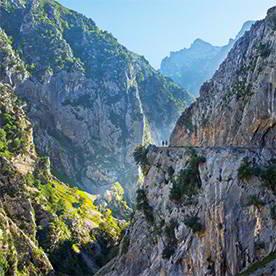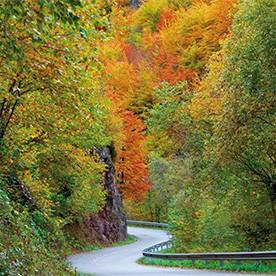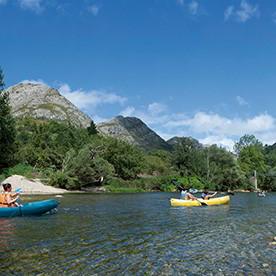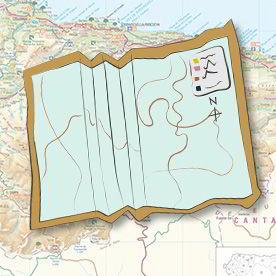Cuadonga/Covadonga is a real natural treasure. It brings together the excellences of Atlantic nature, in a landscape of great beauty that still surprises us today for its purity. So it is not surprising that it was the inspiration for a pioneering figure in the protection of nature. One hundred years ago, Cuadonga/Covadonga and its mountain were the best example of how to preserve the values and attractions of a unique natural environment from human excesses.
The spirit that motivated this pioneering milestone in our country, which was the declaration of the National Park of the Mountain of Covadonga, was summed up wonderfully by its main mentor Pedro Pidal: "The title of National Park is the expression of the beauty, of the beauty, of the natural charms of the homeland...". Pidal thought, with good judgement, that the best way to combine the three Covadongas - historical, spiritual and natural - was the title of National Park.

Picos de Europa from Llueves

Waterfall of the Covadonga River
Many corners of the Royal Site are a natural spectacle
It is obvious that Cuadonga/Covadonga and its surroundings are a true natural spectacle, where every corner has its own unique charm and a lot of history and stories behind it.
A first approach to Cuadonga/Covadonga from Cangues d' Onís/Cangas de Onís, takes us to the Repelao, and there begins the enclosure of the Royal Site of Covadonga and the Picos de Europa National Park (heir to the original National Park after its enlargement in 1995). It is the royal gateway to an area full of natural wonders. The Parque del Príncipe, the waterfall of the River Covadonga, the Mirador de los Canónigos viewpoint, or the Cruz de Priena, at the top of the peak of the same name, are unavoidable references on a route to enjoy the wonders of this natural treasure called Cuadonga/Covadonga.
Gateway to the Royal Site of Covadonga and the National Park of the Picos de Europa, the Repelao field, with its monumental access columns, its royal obelisk, its old railway station, its bridge and its atmosphere indicate that we are in front of a significant historical place that also opens up to a nature overflowing with beauty.
Only a kilometre and a half from the Basilica of Covadonga, El Repelao owes its name to Pelayo, as it is said to be the place where he was proclaimed king, and precisely as a symbol of this event there is an obelisk with the image of the Victoria Cross (the Cross that, according to tradition, Pelayo raised in the Battle of Covadonga, which forms the body of the Victoria Cross, beautifully covered with jewels, nowadays preserved in the Holy Chamber of the Cathedral of Oviedo).
The Prince's Park is a real haven of peace at the foot of the Holy Cave and the Basilica. This garden of Eden has the lushness of the Atlantic forest. And furthermore, as if it were a fairytale place, it is crossed by the River Covadonga and on a quiet stroll you will find beautiful bridges, fountains, waterfalls of spectacular beauty - such as the one just below the cliff of the Basilica - and some buildings of great architectural value such as the old Pilgrims' Inn.
The Parque del Príncipe is an exquisite lung in the heart of Cuadonga/Covadonga for walking, relaxing, or taking photographs.
On the road up to the Lakes, and just a few metres from the start of this famous mountain climb, on the left hand side, is the viewpoint known as the Mirador de los Canónigos. The Mirador de los Canónigos is so called because it was once one of the favourite vantage points for the canons of Cuadonga/Covadonga to contemplate the Sanctuary in peace and quiet, and to relax and chat amidst such green and beautiful scenery.
Nowadays the viewpoint is also one of the favourite places for tourists and pilgrims to have a different view of the Royal Site, appreciating the goodness of nature, and taking a break from the ascent to the Covadonga Lakes.
The Cross of Priena, also known as the Cross of Pelayo, is another of the symbols closely linked to Cuadonga/Covadonga. Located at the top of Picu Priena, a mountain in the foothills of the Picos de Europa, it is very visible from Cuadonga/Covadonga.
Likewise, the ascent to the cross is a wonderful excursion that offers splendid and unusual views of the whole of Cuadonga/Covadonga, as well as of the Picos de Europa and other emblematic mountains such as the Sueve, and even of the Cantabrian Sea itself. It is undoubtedly one of the most complete and beautiful vantage points from which to enjoy the natural temple that is Cuadonga/Covadonga and the Picos de Europa.
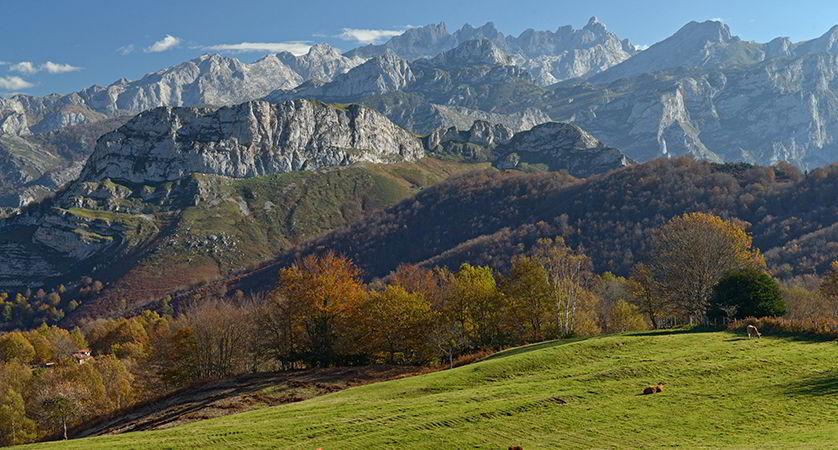
Picos de Europa
This protected area was inaugurated on 8 September 1918.
1918 witnessed the success of a political project that had begun decades earlier and which had had its legal embodiment two years earlier. It was on the afternoon of 8 September of that year that King Alfonso XIII - who had attended the Canonical Coronation of the Virgin of Covadonga in the morning - inaugurated the first protected area as a natural treasure.
This was the culmination of a long journey that in Spain is intimately linked to an Asturian name and place: Pedro Pidal and the Mountain of Covadonga. The Marquis of Villaviciosa was an expert mountaineer who knew these mountains very well. In fact, he had explored them in the company of characters such as the adventurer Roberto Frassinelli, better known as "the German of Corao", who was partly the inspiration behind the establishment of the Covadonga Mountain National Park.
Pedro Pidal, a key figure

Mirador de ordiales
Pedro Pidal was born into a family of Asturian aristocracy and enjoyed the greatest comforts and the best education that his privileged social position could offer him. From a young age, his long summers in Asturias made him a great sportsman - Olympic medallist - and a true lover of Nature, who knew how to cover the Asturian mountains - especially the Picos de Europa - inch by inch, to the point that he is now considered by many to be the first Spanish mountaineer and one of the greatest promoters of mountaineering in our country.
He was a person capable of transferring his concerns to political activity, where he held positions of great responsibility at national level. A member of Parliament from the age of 26 and later a senator for life, his rhetorical skill and his heterodoxy in parliamentary spectacle earned him the nickname of the "Arniches" of Congress.
And he was above all a lover of Asturias, to such an extent that the deep affection he felt for Asturian nature led him to request that, on his death in 1941, his mortal remains be laid to rest in the Mirador de Ordiales, in the heart of the Picos de Europa.
Spain's first National Park

Picos de Europa from Angón in Amieva
As a senator for life, Pedro Pidal was able to develop his most passionate aim: the protection of nature and the implementation of legal measures that would lead to the creation of National Parks in Spain, following the North American model. This explains why his first speech in the Senate in 1915 already set out the outlines of what would become his proposed law.
He presented this proposal for the creation of the legal status of the National Parks in December of that year, and defended it in the following months: "A castle, a tower, a temple is declared a National Monument to save it from destruction. Why shouldn't there be sanctuaries for Nature? These efforts bore fruit at the end of 1916 with the enactment of the National Parks Act, which many then wanted to rename the Pidal Act.
And, as the first place to apply it, Pidal himself - an Asturian, Asturianist and convinced Covadonga supporter - sought to make the Picos de Europa the first example of the new natural protection figure. Thus, on 22 July 1918, the Montaña de Covadonga National Park was created (the first in Spain and one of the first in Europe), which was inaugurated by Alfonso XIII during his visit to Covadonga in September of that year, on the territory of the Western Massif of the Picos de Europa, mostly in Asturias although with part of its extension in the neighbouring province of León.
Picos de Europa today

Vegarredonda in Picos de Europa
The Montaña de Covadonga National Park, which was created in 1918, survived with hardly any changes for almost eighty years. However, in 1995 it disappeared to make way for a new demarcation, now enlarged, but with the same cataloguing and covering the three massifs of the Picos de Europa, as well as important wooded formations on the northern slopes of the Cantabrian Mountains. This is the Picos de Europa National Park, the current name of this area, which has also been declared a Biosphere Reserve, and which incorporates into the traditional protected area more surface area from Asturias and León, and the new incorporation of territory from Cantabria, bringing its current extension to 67,455 ha.

Picu Urriellu from the viewpoint of Pozo de la Oración
The current Picos de Europa National Park includes the three main massifs of this natural wonder, limited by deep valleys and gorges created by the erosion of glaciers and rivers, which give them their beautiful outlines.
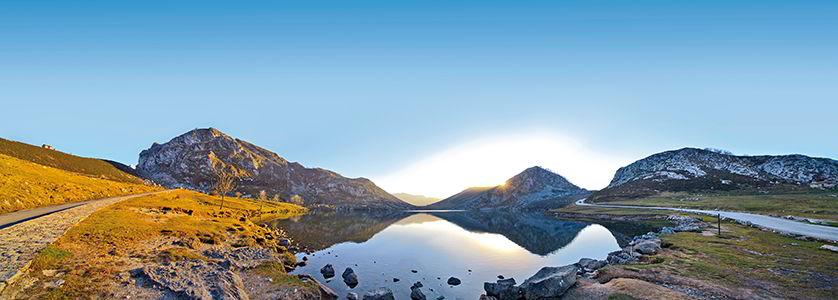
Lake Enol
In the Central Massif we find the highest peaks of the Cantabrian Mountains in the steep Urrieles, where the emblematic Naranjo de Bulnes rises. To the east, the Eastern Massif - the Andara Massif - is smaller and has a gentler profile. The westernmost of the three massifs is the Picos del Cornión, where the Sanctuary of Covadonga and the lakes Enol and La Ercina are located.
Between them flow mighty and mighty rivers such as the Cares, whose crystal-clear waters lash its entire course, or the Dobra river. All this in a landscape of imposing contrasts and virginal natural beauty that allows you to lose yourself in the greenery of the oak, beech and birch forests or contemplate the purity of its white snow-capped peaks.
The best way to enjoy the Picos de Europa National Park and its surroundings is to prepare your visit in advance, taking the necessary time. To make it unforgettable, the Visitor Centres and Information Points set up by the National Park are very useful, including the "Pedro Pidal" Visitor Reception Centre, located at the foot of the old Buferrera mines and just a few metres from the lakes of La Ercina and Enol.
It is also an incomparable sensation to contemplate the spectacular landscape of the Picos de Europa at viewpoints (more than twenty are scattered throughout the National Park and its surroundings) that offer dream views, such as the Ordiales viewpoint overlooking the Angón valley or the Camarmeña viewpoint on Poncebos with views of the Urriellu, as well as the King's viewpoint, which shows the magical beech forest of Pome or the Queen's viewpoint, which allows you to see countless valleys and mountains overlooking the Bay of Biscay, as well as the many birds that soar in the skies above.
Like all historical sites, the Picos de Europa National Park has in its memory the names of people who marked its origin and evolution. In addition to some well-known names such as Pedro Pidal, Gregorio Pérez "El Cainejo" or Roberto Frassinelli, we can count mountaineers such as the Count of Saint Saud or José Ramón Lueje; researchers such as the geologists Casiano de Prado, Hugo Obermaier or Guillermo Schulz; and important authors and writers who have made the beauty of this place known, such as Guillermo Muñoz Goyanes, Joaquín Fernández Sánchez or Guillermo Mañana. They are a remarkable but small selection of the men and women who wove the history and intrahistory of a unique natural space in the world.
The Picos are an ideal space for sport and science
The Picos de Europa National Park is a great monument destined to pamper and protect nature, where there is room for the mark of history, where the mind is serene and where human beings find a suitable ecosystem to immerse themselves in the landscape and set goals of self-improvement, be they sporting or improving their knowledge of the environment, just as Pedro Pidal and many others who, like him, were fascinated by this space and its infinite possibilities, dreamt of.
There is no doubt that Picos de Europa is a place where mountain sports and outdoor leisure have one of the best possible settings. For this reason, many people get to know this Park through sporting activities such as hiking, climbing, mountain races, cycling or potholing, the development of which is regulated by regulations that guarantee the conservation of the area. The Picos are also a great open-air laboratory for the numerous scientific expeditions that frequently set their sights on this natural space.
Pedro Pidal was an expert and passionate mountaineer, who travelled many times through many of the corners of what is now the Picos de Europa National Park. It is therefore not surprising that he is credited with writing the first great page of Spanish mountaineering: the conquest in the summer of 1904 of the Naranjo de Bulnes or Picu Urriellu on its north face, in the company of a shepherd from the area called Gregorio Pérez, also known as "El Cainejo", whom Pidal himself would later appoint as the head ranger of the Royal Reserve of the Picos de Europa. Between the two of them they built one of the most fascinating episodes of human achievement, especially considering that the Picu Urriellu was the last great European summit to be conquered.
The Picos de Europa are well known in world sport thanks to their inclusion as a frequent stage finish in the Vuelta Ciclista a España since its 1983 edition. It is an arduous climb surrounded by an incomparable natural setting that has become over the years the most emblematic climb of the Spanish round. A stage that, due to its toughness and beauty, never disappoints and has made the Lagos de Covadonga a witness to great feats of national and international cycling, and has made it a truly familiar stage for millions of sports and nature lovers.
In the central massif of the Picos de Europa, at the foot of the Cuetos del Trave, in the council of Cabrales, there is an underground system formed by three interconnected chasms which, with a depth of 1,661 metres, makes it the second deepest chasm in Spain. Discovered in 1982, it has several underground watercourses, and is an ideal setting for caving and scientific research. Since 2005 it has been declared a Natural Monument. The fact is that the perforated and limestone subsoil of the Picos de Europa, with numerous other chasms, makes this area a perfect testing ground for sport, for training and for research into the natural environment. The Picos de Europa, due to the abundance, depth and characteristics of its chasms and subterranean systems, are the true Himalayas of the "lessmiles" (the equivalent of an "eight-thousander", but in the depths of the earth).
The National Park is a deeply humanised space
From its earliest days, the National Park was inserted into a populated and humanised ecosystem, as one of its main aims was to revalue the quiet, long-suffering, wise and daily work of the inhabitants in secular communion with nature, preserving this space from indiscriminate use, speculation and deterioration, which were already beginning to be seen as something negative for the natural enclave.
Both in the first delimitation of the Covadonga Mountain Park and in its enlargement in 1995, the protected area had a considerable number of settlements within the park boundaries and more than 1,500 people live in it today, making it one of the most inhabited National Parks in the world even today, to the extent that the Picos de Europa are a landscape with figures, with a landscape that is inseparable from its environment, and which brings richness and diversity to this natural environment.

Sotres
A life between the valley and the port

Majada de Belbín in Onís
Until a few decades ago, life in the Picos de Europa region was marked mainly by agricultural and livestock activities, and by a short-range transhumance in a constant and seasonal flow between the valley and the pass. Families lived, depending on the time of year and the needs of production, between the pass in summer, tending the livestock, and the sheltered villages in the valley in winter.
It was a life that unfolded between the bucolic and the necessary survival, between imagination and duty, between peace and quiet and the hustle and bustle of daily work. Kilometres travelled through valleys and mountains in search of livestock, hours of cheese making in the huts and sheepfolds. Devotion and obligation were combined for centuries and centuries, and still are, in the beautiful landscapes of the Picos where the pulse of the increasingly scarce pastoral life can be felt, and where time seems to have stopped, as if in an eternal dream.
The sound of the cattle's "lloqueros" (shearing) resounds like a concert in the open valleys and sets the peaks of the Picos de Europa to music. The knowledge of centuries is gathered in every cheese and in every hut, and in every gesture of gratitude towards nature.
The Shepherds of Picos de Europa, an Exemplary People

Shepherds of the Picos de Europa
In 1994, the then Prince of Asturias Foundation - today the Princess of Asturias - recognised the importance of the human community settled in this natural area, awarding the Exemplary People of Asturias Award to the nomination of the "Shepherds of the Picos de Europa". The jury then considered them to be a human group that has inherited and passed on a centuries-old tradition of seasonal grazing in the sheepfolds and high altitude pastures, with important values and their own identity, governing bodies and ways of life that stand out for their high concept of solidarity and for the voluntary maintenance of traditional ways of life that have allowed a respectful symbiosis with the natural environment in which they live.
The shepherds of Picos de Europa continue to be today - although they are numerically smaller than in 1994 - a human group that stands out for its values of coexistence and unconditional love for an environment that has seen generations and generations of human beings survive in a sometimes hostile natural environment, transmitters of a culture and a way of life that is unique on the planet.
The pastoral culture of Picos de Europa is also a highly valuable intangible heritage to be preserved.
A great gastronomic heritage for Humanity

Gamonéu del puerto cheese
The traditional way of life in this region meant that the shepherds had to live for long periods of time in the mountain passes, which is why the use of milk from livestock was one of their main productive and survival activities. Thus, the Picos de Europa area is home to the largest production of artisanal cheeses in Asturias, such as Gamonéu del Puertu and del Valle, produced in the sheepfolds of Cangas and Onís, Cabrales, or Los Beyos, characterised by excellence both in their production and in the possibilities for use in the kitchen in dozens of traditional recipes. Similarly, on the Cantabrian and Leonese sides of the National Park, cheeses of singular variety and quality are produced.
The artisan cheeses of Picos de Europa are deservedly famous throughout the world and form part of the great cultural, tangible and intangible legacy handed down from time immemorial through this unique group of people. Creations such as Gamonéu or Cabrales form part of the gastronomic heritage of humanity.
Other tasty and healthy examples of making the most of the possibilities of this natural environment are the harvesting of honey or raw materials for infusions, such as rock tea, camomile or wild lime blossom. Not to be forgotten are the orujo or cider, great and characteristic products of Asturian culture.
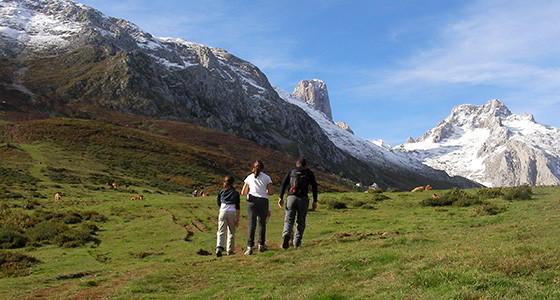
Routes and active tourism
The Eastern Region of Asturias and especially the Picos de Europa National Park offers you the chance to enjoy various active tourism activities as well as routes on foot or by car.
Here you will find all this information, together with maps, brochures and all the necessary guidelines for a happy stay in the Picos de Europa National Park.

